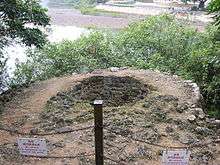Tsam Chuk Wan
Tsam Chuk Wan (Chinese: 斬竹灣) is a bay of the Sai Kung Peninsula in Hong Kong. By extension, it is also the name of the area around the bay. Tsam Chuk Wan Village (斬竹灣村) is one of the villages located within this area.
.jpg)

History
A Catholic missionary station was established at Tsam Chuk Wan between 1867 and 1869.[1]
In 1911 Pak Tam Chung consisted of six villages with fewer than 405 inhabitants in total: Wong Yi Chau (黃宜洲), Pak Tam (北潭), Sheung Yiu (上窰), Tsak Yu Wu (鯽魚湖), Wong Keng Tei (黃麖地) and Tsam Chuk Wan. The six villages were all inhabited by Hakka people, with the exception of two hamlets in Pak Tam.[2][3]
The population of Tsam Chuk Wan Village (斬竹灣村) was 74 in 1911.[2] In the 1950s, it was about 55, as recorded by Austin Coates and James W. Hayes.[4]
Islands
Islands of Tsam Chuk Wan include:[5]:607
- Muk Yue Chau (木魚洲)
- Ching Chau (青洲)
- Nga Ying Chau (牙鷹洲)
- Wong Nai Chau Tsai (黄泥洲仔)
- Wong Yi Chau (黄宜洲)
Features
Features around the bay include (from West to East):
- Memorial Monument of Sai Kung Martyrs of World War II (西貢烈士墓園). Unveiled on January 23, 1989.[6][7]
- Hong Kong Sea Cadet Corps Tang Shiu Kin Nautical Centre (香港海事青年團鄧肇堅海事康樂中心)
- Queen Elizabeth School Camp (伊利沙伯中學校營)[8]
- Tsam Chuk Wan Village (斬竹灣村)
- Wong Keng Tei Tin Hau Temple (黃麖地天后古廟) aka. Tsam Chuk Wan Tin Hau Temple. Located off Tai Mong Tsai Road (斬竹灣天后廟), and overlooking Tsam Chuk Wan
- Wong Keng Tei (黃麖地), a village
- Po Leung Kuk Pak Tam Chung Camp (保良局北潭涌渡假營)
- Sheung Yiu Folk Museum, housed in Sheung Yiu (上窰) Village, a declared monument of Hong Kong
- Our Lady of the Seven Sorrows Chapel (聖母七苦小堂). Built in 1900, it is one of the historic churches of Sai Kung.[9][10]
- Wong Yi Chau (黃宜洲), a village
See also
References
- Ticozzi, Sergio (2008). "The Catholic Church in Nineteenth Century Village Life in Hong Kong" (PDF). Journal of the Royal Asiatic Society Hong Kong Branch. 48: 128. ISSN 1991-7295. (A previous version of this paper was presented at a Seminar 'Hong Kong: its people, culture and traditions, the Centre of Asian Studies, University of Hong Kong. 15-16 April 1983)
- Faure, David (1986). The structure of Chinese rural society: lineage and village in the eastern New Territories, Hong Kong. Oxford University Press. pp. 90, 209. ISBN 9780195839708.
- Delang, Claudio O. (30 March 2018). "Local livelihoods and global process: complex causalities in Hong Kong's Sai Kung Peninsula". Miscellanea Geographica. 22 (1): 31–39. doi:10.2478/mgrsd-2018-0003. ISSN 2084-6118.
- Strickland, John (2010). Southern District Officer Reports: Islands and Villages in Rural Hong Kong, 1910-60. Hong Kong University Press. p. 270. ISBN 9789888028382.
- 胡普炜 [Hu Puwei]; 邢福武 [Xing Fuwu]; 陈林 [Chen Lin]; 王美娜 [Wang Meina]; 王发国 [Wang Faguo]; 陈红锋 [Chen Hongfeng] (2011). 香港西贡牛尾海邻近岛屿植被与 植物物种多样性 [Vegetation and vascular plant diversity of islands surrounding Port Shelter, Hong Kong, China]. Biodiversity Science (in Chinese). 19 (5): 605–609. doi:10.3724/SP.J.1003.2011.05049.
- Lo, Shuk-Ying (2006). "Monuments to Hong Kong's World War II Dead, 1945-2005" (PDF). Journal of the Royal Asiatic Society Hong Kong Branch. 46: 75–100. ISSN 1991-7295.
- Memorial Monument of Sai Kung Martyrs of World War II at Film Services Office database
- Queen Elizabeth School Camp
- Heaver, Stuart (27 February 2016). "The abandoned churches of Sai Kung: how Italian missionaries established Hakka congregations in Hong Kong". South China Morning Post.
- Our Lady of the Seven Sorrows Chapel at catholic.org.hk